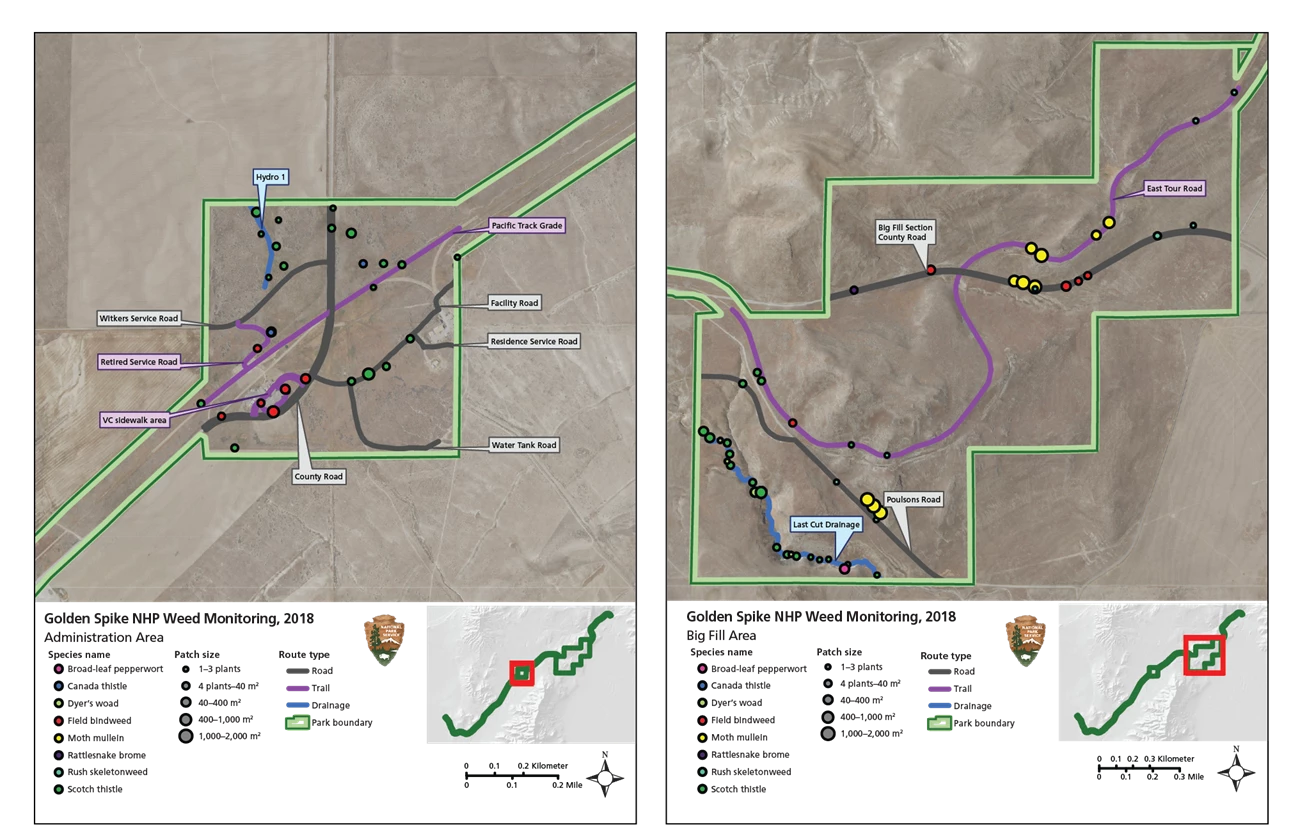Last updated: September 1, 2022
Article
Invasive Exotic Plant Monitoring at Golden Spike National Historical Park, 2018

Invasive exotic plants are one of the most significant threats to natural resources in the national parks today. To provide early warning of weed invasions, the Northern Colorado Plateau Network (NCPN) monitors for these species in areas where they are likely to first establish: along roads, trails, and waterways.

Leslie J. Mehrhoff, University of Connecticut, Bugwood.org
What Are Invasive Exotic Plants?
Invasive exotic plants (IEPs) are species whose introduction to an environment “does or is likely to cause economic or environmental harm or harm to human health.” In national parks, IEPs can alter ecosystems at multiple scales—threatening wildlife, natural landscapes, and recreational opportunities.
IEPs are able to reproduce prolifically, rapidly colonize new areas, and displace native species. Invasive plants fill different ecological roles than the native plants they replace, leaving gaps in the system. In the absence of the native plants, the needs of species that depended on the native vegetation may go unmet, potentially creating a cascade of ecological effects.
The good news is that if discovered before they have a chance to take hold, IEP populations can be eradicated from parks. Small populations are cheaper and easier to control than large populations. Therefore, early detection is critical.
What Can Be Done?
To help park managers identify IEPs and prioritize control efforts, the Northern Colorado Plateau Network (NCPN) monitors invasive exotic plants in eight National Park Service units. First, network and park staff create a list of priority IEPs for each park. Then, on a rotating schedule, a field crew visually surveys for those IEPs along established monitoring routes. Along the routes, they stop and set up plots for additional data collection. The plot data allow network ecologists to estimate trends over time.
During data analysis, a Patch Management Index (PMI) helps identify the scale of the problem presented by each patch of exotic plants. PMI multiplies the size of each patch by the amount of each patch that is covered in weeds to arrive at a composite score. The PMI score is assigned to a class ranging from very low to very high.
To be useful, PMI must be considered in combination with species and patch numbers. In many cases, targeting patches with very low or low PMI allows managers to keep small patches from growing into bigger problems. On the other hand, a species with many patches of very low or low PMI may be harder to treat than a different species with just a few patches of high or very high PMI.

Recent Monitoring at Golden Spike National Historical Park
During monitoring on July 2–4, 2018, a total of 17 different IEP species were detected along 20 kilometers (12.4 mi) of 13 monitoring routes and 42 transects at Golden Spike National Historical Park. Of these, seven were priority species that accounted for 73 separate patches. Three additional IEP species were recorded only in transects. Almost all patches (96%) were classified as “very low” or “low” on the patch management index scale, suggesting that effective control or eradication is possible through local management actions.
Scotch thistle (Onopordum acanthium) was the most prevalent priority species, representing 51% of all recorded patches. Field bindweed (Convolvulus arvensis), rush skeletonweed (Chondrilla juncea), and moth mullein (Verbascum blattaria) constituted most other patches. One patch of broad-leaf pepperwort (Lepidium latifolium) and one patch of Canada thistle (Cirsium arvense) were found in 2018; neither species had been found since 2014.
| Scientific name | Common name |
| Agropyron cristatum** | crested wheatgrass |
| Bassia scoparia | summer cypress |
| Bromus briziformis | rattlesnake brome |
| Bromus japonicus | Japanese brome |
| Bromus tectorum** | cheatgrass |
| Cirsium arvense* | Canada thistle |
| Chondrilla juncea* | rush skeletonweed |
| Convolvulus arvensis* | field bindweed |
| Descurainia sophia | tansy mustard |
| Isatis tinctoria* | Dyer’s woad |
| Lepidium latifolium* | broad-leaf pepperwort |
| Melilotus officinalis | yellow sweetclover |
| Onopordum acanthium* | Scotch thistle |
| Salsola sp. | Russian thistle |
| Sisymbrium altissimum** | tumble mustard |
| Tragopogon dubius | yellow salsify |
| Verbascum blattaria* | moth mullein |
*Priority species
**Species searched for only in transects
The number of IEP patches and total IEP patches per kilometer did not change greatly between 2016 (67/3.43) and 2018 (73/3.74). The total IEP patches per kilometer remained lower than in 2014 (4.96), but has increased since the earlier monitoring seasons of 2010 (2.33) and 2012 (0.36).
The highest densities of plant patches were recorded along the Hydro 1 (20.3/km) and Last Cut (10.7/km) drainages and Retired Service (11.5/km) and Facility (7.4/km) roads.
Network staff will return to re-sample all monitoring routes in 2020.
For more information, see A. Washuta and D. W. Perkins, Invasive Exotic Plant Monitoring in Golden Spike National Historical Park: 2018 Field Season
